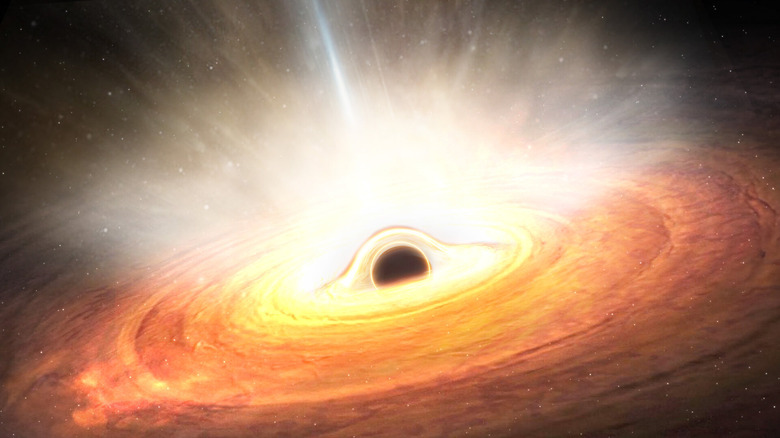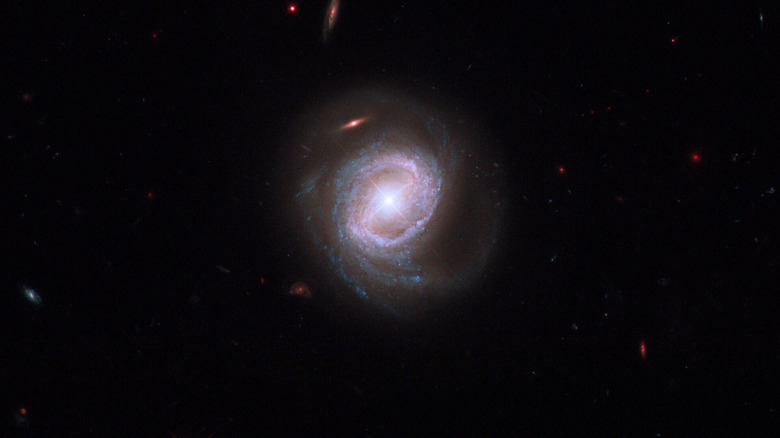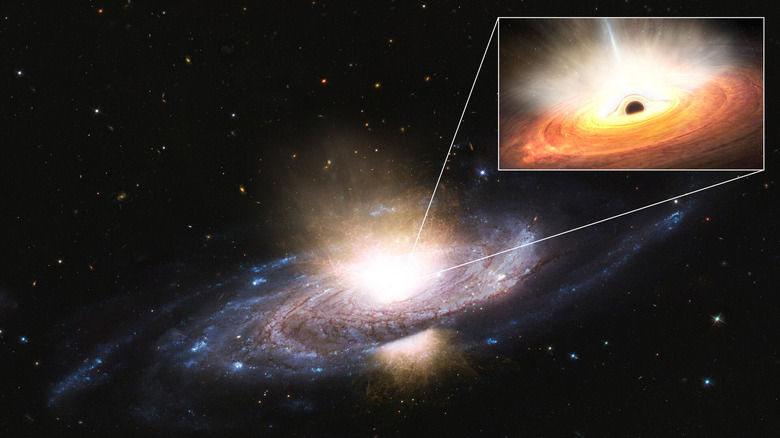Astronomers Spotted A Black Hole 'Flipping The Table' - Here's How
Black holes are famous for being impossible to see directly. Everything that comes close to them, even light, gets sucked in by their enormously strong gravity, meaning the black holes themselves are dark. However, that doesn't mean scientists can't detect them. They can still see black holes like the famous Sagittarius A* at the center of our galaxy by looking just beyond the bounds of the black holes themselves. The boundary at which everything gets sucked into a black hole is called the event horizon. We can't see anything inside the event horizon, but we can see things outside of it. And some black holes have very busy regions of gas swirling around the edges of these event horizons. As this gas gets dense and hot due to friction, it gives off energy which scientists can detect. Very hot gas gives off X-rays, which can be observed from even a great distance away.
Recently, astronomers observed X-rays coming from a black hole during a dramatic feeding session, showing, as they call it, terribly bad table manners. The observations were made using a European Space Agency (ESA) mission called XMM-Newton, a space-based observatory that detects X-rays and particularly studies what happens in these hot, bright regions around the edges of black holes. The XMM-Newton was launched back in 1999 but is still providing data more than 20 years later, using a set of three telescopes containing a total of 170 extremely thin mirrors, making it sensitive to X-rays from even distant sources like black holes.
[Featured image by ATG via ESA | Cropped and scaled | CC BY-SA 3.0 IGO]
A messy eater of a black hole
The study, published in "The Astrophysical Journal Letters," looked at what happens as a black hole feeds. The strong gravity from the black hole attracts gas, which slowly begins to spin as it comes closer to the event horizon. This spinning causes the gas to flatten into a disc shape, called an accretion disc, where the gas gets hotter and hotter over time. When gas passes the event horizon and falls into the black hole, it is informally referred to as feeding. But something interesting happens to some of this gas. Not all of it falls into the black hole, as some is thrown away from the black hole and into space — "much like how a messy toddler spills a lot of what lies on their plate," as ESA puts it.
This phenomenon is well known, but sometimes an extreme version occurs when the black hole "flips the table" by throwing out gas so fast that it empties the surrounding region of space. This leaves no more material for new stars to form in the vicinity, making a permanent change to the galaxy in which the black hole resides. This is known as an ultra-fast black hole wind and was observed in the new research — surprisingly, as the black hole in question was not in an especially bright accretion disc. "You might expect very fast winds if a fan was turned on to its highest setting. In the galaxy we studied, called Markarian 817, the fan was turned on at a lower power setting, but there were still incredibly energetic winds being generated," said researcher Miranda Zak of the University of Michigan.
How these black holes shape their galaxies
When ultra-fast black hole winds have been occasionally observed before, they have usually been coming from extremely hungry black holes which are drawing in gas at a very high rate. But in this case, the black hole observed was more moderate. "It is very uncommon to observe ultra-fast winds, and even less common to detect winds that have enough energy to alter the character of their host galaxy. The fact that Markarian 817 produced these winds for around a year, while not being in a particularly active state, suggests that black holes may reshape their host galaxies much more than previously thought," said fellow researcher Elias Kammoun of the Roma Tre University, Italy.
This is important because it shows how these black holes can affect the galaxies around them. Stars form from clouds of dust and gas which float around between existing stars. Over time, this gas and dust can clump together, forming knots that attract more dust and gas. These gravitationally bound structures become the beginning of stars, called protostars. When a black hole sends out these winds, if they are powerful enough they can blow away dust and gas from a large region around the black hole. Without this dust and gas, no new stars can form in the area. This can leave a void in the region around the black hole, with no star formation occurring, which changes the look of the galaxy in the long term.
[Featured image by ATG via ESA | Cropped and scaled | CC BY-SA 3.0 IGO]
How the black hole winds were detected
The researchers used the XMM-Newton observatory to follow up on previous signals from the NASA Swift observatory, which is a satellite that primarily studies gamma-ray bursts. It does detect X-rays, and so was able to see some signal from the black hole in Markarian 817, but only very faintly. Using the more sensitive XMM-Newton, the researchers were able to get a better picture of the black hole. The reason the signals had been faint was that the winds being given off were so powerful that they were blocking X-rays coming from the accretion disc. That's because the black hole didn't just give out one puff of wind, but rather it blew dust in all different directions over a period of several hundred days. The wind was fast enough to reach several percent of the speed of light.
By observing the black hole over a longer period of time using XMM-Newton, the researchers were able to see the effects of these winds as they stretched over a period of months. "Many outstanding problems in the study of black holes are a matter of achieving detections through long observations that stretch over many hours to catch important events," said XMM-Newton project scientist Norbert Schartel of ESA. "This highlights the prime importance of the XMM-Newton mission for the future. No other mission can deliver the combination of its high sensitivity and its ability to make long, uninterrupted observations."



